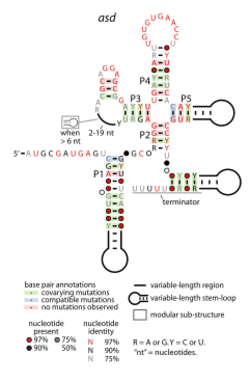Biology:Asd RNA motif
| asd RNA motif | |
|---|---|
 Consensus secondary structure of asd RNAs. The stem marked "terminator" is predicted as a Rho-independent transcription terminator. | |
| Identifiers | |
| Symbol | asd RNA |
| Rfam | RF01732 |
| Other data | |
| RNA type | sRNA |
| Domain(s) | Streptococcaceae |
| SO | 0000655 |
| PDB structures | PDBe |
The asd RNA motif is a conserved RNA structure found in certain lactic acid bacteria. The asd motif was detected by bioinformatics[1] and an individual asd RNA in Streptococcus pyogenes was detected by microarray and northern hybridization experiments as a 170-nucleotide molecule called "SR914400".[2] The transcription start site determined for SR914400 corresponds to the 5′-end of the molecule shown in the consensus diagram.
Some asd RNA are associated with genes, such as asd, that are suggestive of a cis-regulatory function.[3] However, several lines of evidence suggest that this is not the biological role of asd RNAs. First, in some cases, the asd RNA is not in the 5' untranslated region of any annotated gene. Second, in Streptococcus mutans, there is a strong promoter[4] immediately downstream of the transcription terminator that follows the asd RNA, and this promoter precedes the downstream gene. This arrangement suggests that asd RNA transcription is terminated, and the gene is transcribed from the downstream promoter. Finally, although the asd gene encodes an enzyme, aspartate-semialdehyde dehydrogenase, that participates in the synthesis of methionine, lysine and threonine, transcription levels of the asd gene remain constant even when the concentrations of these amino acids are varied.[4]
The sRNA was shown to interact with the 5'UTR of the mga transcript (the multiple virulence gene regulator gene) and was renamed MarS for mag-activating regulatory sRNA. In MarS deletion strains expression of mga and several Mga-activated genes is reduced. This down-regulation of virulence factors leads to increased susceptibility of the deletion strain to phagocytosis, reduced adherence to human keratinocytes. However, the lack of MarS increased bacterial dissemination and tolerance towards oxidative stress.[5]
References
- ↑ "Comparative genomics reveals 104 candidate structured RNAs from bacteria, archaea, and their metagenomes". Genome Biology 11 (3): R31. March 2010. doi:10.1186/gb-2010-11-3-r31. PMID 20230605.
- ↑ "A genome-wide analysis of small regulatory RNAs in the human pathogen group A Streptococcus". PLOS ONE 4 (11): e7668. November 2009. doi:10.1371/journal.pone.0007668. PMID 19888332. Bibcode: 2009PLoSO...4.7668P.
- ↑ "Single nucleotide resolution RNA-seq uncovers new regulatory mechanisms in the opportunistic pathogen Streptococcus agalactiae". BMC Genomics 16 (1): 419. May 2015. doi:10.1186/s12864-015-1583-4. PMID 26024923.
- ↑ 4.0 4.1 "Nucleotide sequence of the asd gene of Streptococcus mutans. Identification of the promoter region and evidence for attenuator-like sequences preceding the structural gene". The Journal of Biological Chemistry 262 (7): 3344–3353. March 1987. doi:10.1016/S0021-9258(18)61509-1. PMID 2434499.
- ↑ "The Regulatory Small RNA MarS Supports Virulence of Streptococcus pyogenes". Scientific Reports 7 (1): 12241. September 2017. doi:10.1038/s41598-017-12507-z. PMID 28947755. Bibcode: 2017NatSR...712241P.
External links
 |

